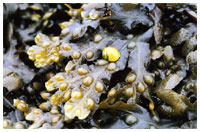
Interactions
.jpg) There's just not
enough room
There's just not
enough room
Fucus
vesiculosus is not the only algae in its environment.
Bladderwrack faces competition from a number of other algae such
as Ascophyllum nodosum and Fucus spiralis
(shown to the left). The competition between these species seems
very intense, but somehow F. vesiculosus is able to
remain the dominant species in most places along the coast. The
reason for this is because F. vesiculosus is able to
grow a lot faster than either of the aforementioned species.
Other species, however, can outgrown bladderwrack, but these
tend to have a shorter life span. Once the species has died off,
F. vesiculosus is able to restart its growth and once
again become the dominant species in the area. The only
thing that bladderwrack has going against it is its shorter
lifespan of 4-5 years, but it is able to overcome this in most
cases.
Housing
Bladderwrack serves another function in its ecosystem other
than a primary producer; it provides shelter for many organisms.
Since bladderwrack grows so densely in areas, many species are able
to seek protection from predators in the thalli of bladderwrack. The
brown algae also provides protection against the current and waves,
and also shields many organisms from the suns rays and the heat that
comes with it.
 Eat
or be eaten
Eat
or be eaten
Unfortunately, bladderwrack has no means to eat
organisms that are feeding on it. There are quite a few marine
species of gastropods, or snails, that use bladderwrack as its main
means of nutrition. An example would be Littorina littoralis.
There is also a yellow-shelled snail on the bladderwrack thallus in
the picture to the right. Can you spot it? You can also learn more
about gastropods by visiting
this site. But not only
do marine organisms eat bladderwrack, humans do as well. According
to
celtnet.org, Buttered
Bladderwrack is a traditional British dish that goes well with any
main course.
Fucus vesiculosus is also a major source of dissolved organic carbon (DOC), which is a broad set of molecules that dissolve into the water once they are released by the organism. DOCs are the main source of nutrients for many microorganisms that live in the vicinity of F. vesiculosus. They are also the main way in which carbon cycles around not only an ecosystem, but the world as a whole. DOCs are produced by many marine and aquatic organisms, and can be found in any body of water that contains life, from streams to seas.